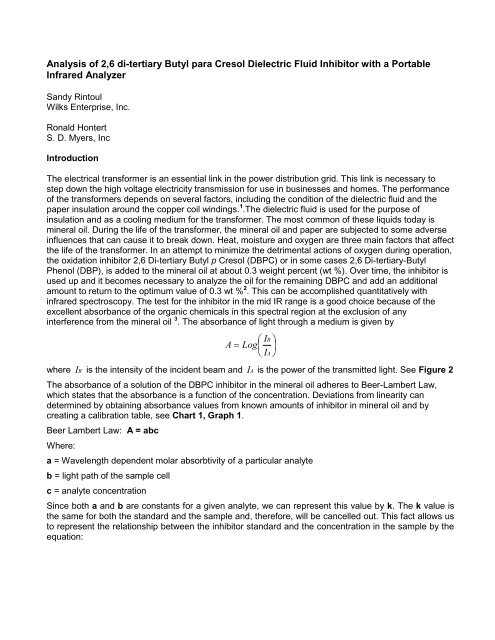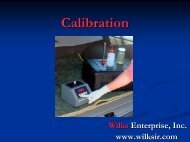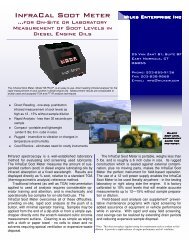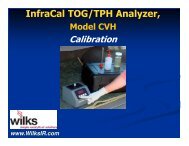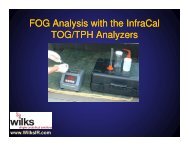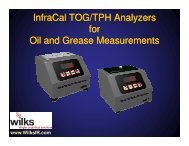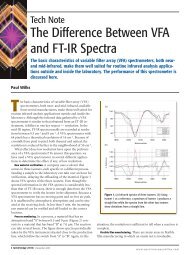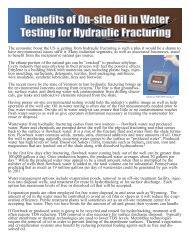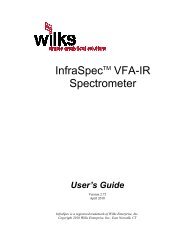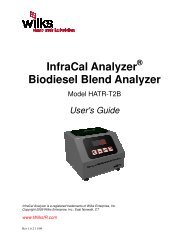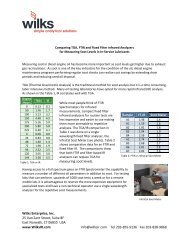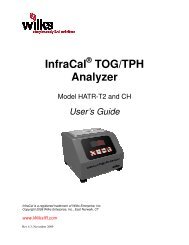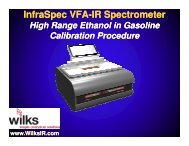Antioxidant in Transformer Oil Measurment - Wilks Enterprise, Inc.
Antioxidant in Transformer Oil Measurment - Wilks Enterprise, Inc.
Antioxidant in Transformer Oil Measurment - Wilks Enterprise, Inc.
Create successful ePaper yourself
Turn your PDF publications into a flip-book with our unique Google optimized e-Paper software.
Analysis of 2,6 di-tertiary Butyl para Cresol Dielectric Fluid Inhibitor with a Portable<br />
Infrared Analyzer<br />
Sandy R<strong>in</strong>toul<br />
<strong>Wilks</strong> <strong>Enterprise</strong>, <strong>Inc</strong>.<br />
Ronald Hontert<br />
S. D. Myers, <strong>Inc</strong><br />
Introduction<br />
The electrical transformer is an essential l<strong>in</strong>k <strong>in</strong> the power distribution grid. This l<strong>in</strong>k is necessary to<br />
step down the high voltage electricity transmission for use <strong>in</strong> bus<strong>in</strong>esses and homes. The performance<br />
of the transformers depends on several factors, <strong>in</strong>clud<strong>in</strong>g the condition of the dielectric fluid and the<br />
paper <strong>in</strong>sulation around the copper coil w<strong>in</strong>d<strong>in</strong>gs. 1 .The dielectric fluid is used for the purpose of<br />
<strong>in</strong>sulation and as a cool<strong>in</strong>g medium for the transformer. The most common of these liquids today is<br />
m<strong>in</strong>eral oil. Dur<strong>in</strong>g the life of the transformer, the m<strong>in</strong>eral oil and paper are subjected to some adverse<br />
<strong>in</strong>fluences that can cause it to break down. Heat, moisture and oxygen are three ma<strong>in</strong> factors that affect<br />
the life of the transformer. In an attempt to m<strong>in</strong>imize the detrimental actions of oxygen dur<strong>in</strong>g operation,<br />
the oxidation <strong>in</strong>hibitor 2,6 Di-tertiary Butyl p Cresol (DBPC) or <strong>in</strong> some cases 2,6 Di-tertiary-Butyl<br />
Phenol (DBP), is added to the m<strong>in</strong>eral oil at about 0.3 weight percent (wt %). Over time, the <strong>in</strong>hibitor is<br />
used up and it becomes necessary to analyze the oil for the rema<strong>in</strong><strong>in</strong>g DBPC and add an additional<br />
amount to return to the optimum value of 0.3 wt % 2 . This can be accomplished quantitatively with<br />
<strong>in</strong>frared spectroscopy. The test for the <strong>in</strong>hibitor <strong>in</strong> the mid IR range is a good choice because of the<br />
excellent absorbance of the organic chemicals <strong>in</strong> this spectral region at the exclusion of any<br />
<strong>in</strong>terference from the m<strong>in</strong>eral oil 3 . The absorbance of light through a medium is given by<br />
I<br />
A Log<br />
I<br />
where I R is the <strong>in</strong>tensity of the <strong>in</strong>cident beam and I A is the power of the transmitted light. See Figure 2<br />
The absorbance of a solution of the DBPC <strong>in</strong>hibitor <strong>in</strong> the m<strong>in</strong>eral oil adheres to Beer-Lambert Law,<br />
which states that the absorbance is a function of the concentration. Deviations from l<strong>in</strong>earity can<br />
determ<strong>in</strong>ed by obta<strong>in</strong><strong>in</strong>g absorbance values from known amounts of <strong>in</strong>hibitor <strong>in</strong> m<strong>in</strong>eral oil and by<br />
creat<strong>in</strong>g a calibration table, see Chart 1, Graph 1.<br />
Beer Lambert Law: A = abc<br />
Where:<br />
a = Wavelength dependent molar absorbtivity of a particular analyte<br />
b = light path of the sample cell<br />
c = analyte concentration<br />
S<strong>in</strong>ce both a and b are constants for a given analyte, we can represent this value by k. The k value is<br />
the same for both the standard and the sample and, therefore, will be cancelled out. This fact allows us<br />
to represent the relationship between the <strong>in</strong>hibitor standard and the concentration <strong>in</strong> the sample by the<br />
equation:<br />
R<br />
A
A<br />
Astd<br />
unknown<br />
C<br />
<br />
C<br />
std<br />
unknown<br />
Dielectric fluid is typically sampled <strong>in</strong> the field by a service technician and delivered to a remote<br />
laboratory for completion of the test. A study was undertaken to determ<strong>in</strong>e whether a portable <strong>in</strong>frared<br />
<strong>in</strong>strument could be used to analyze the dielectric fluid for <strong>in</strong>hibitor content at the field location.<br />
Experimental Section<br />
Chemicals<br />
The m<strong>in</strong>eral oil used <strong>in</strong> this experiment is un<strong>in</strong>hibited transformer oil similar to Shell Diala A. The 2,6 Ditert–Butyl-ρ-Cresol<br />
(DBPC) also knows as 2,6 Di-tert-Butyl-4-Methylphenol used for the standards can<br />
be obta<strong>in</strong>ed from Fluka Chemika as Fluka number 34750. The sample cells can be cleaned with<br />
commonly available Shell VM&P Naphtha.<br />
Instruments<br />
The <strong>in</strong>frared analyzer spectrophotometer should be a portable, battery powered <strong>in</strong>strument that is<br />
capable of transport to remote locations void of an electrical power supply. The <strong>in</strong>strument, which is a<br />
fixed wavelength filter, should be capable of produc<strong>in</strong>g an absorbance read<strong>in</strong>g at 3650cm -1 (2.7 μm) 1 .<br />
An example of such an <strong>in</strong>strument is the portable <strong>Wilks</strong> InfraCal Filtometer (see Figure 1). This<br />
portable <strong>in</strong>strument used for this purpose has a resolution wavelength listed at 40 cm -1.<br />
Figure 1<br />
<strong>Wilks</strong> InfraCal Filtometer<br />
Sample<br />
Filters (I R / I A )<br />
Source<br />
Detectors<br />
A = log (I R / I A )<br />
Figure 2 The Measurement of IR Absorption of a transparent sample by Transmission
Procedure<br />
A 0.55 wt/% DBPC standard is prepared by dissolv<strong>in</strong>g 0.487 g of the <strong>in</strong>hibitor <strong>in</strong> 88 g un<strong>in</strong>hibited virg<strong>in</strong><br />
oil <strong>in</strong> a 250 mL. flask, with heat<strong>in</strong>g, <strong>in</strong> an oven at 50°C. The flask was removed from the oven and<br />
cooled to ambient temperature before the calibration step. After the DBPC was completely dissolved,<br />
the standard was transferred to a conta<strong>in</strong>er with a screw cap.<br />
The <strong>in</strong>frared spectrometer was set up accord<strong>in</strong>g to the <strong>in</strong>strument manual. This portable <strong>in</strong>strument has<br />
no optical air path, so there is no need to purge the sample compartment with an <strong>in</strong>ert gas as is<br />
typically done. Calibration was <strong>in</strong>itiated by first draw<strong>in</strong>g up from the supply of un<strong>in</strong>hibited virg<strong>in</strong> oil used<br />
<strong>in</strong> mak<strong>in</strong>g the DBPC standard <strong>in</strong>to a 10 ml syr<strong>in</strong>ge and transferred <strong>in</strong>to a clean sealed sample cell with<br />
a 0.5 to 1.0 mm path-length. The virg<strong>in</strong> oil was run on the <strong>in</strong>strument to determ<strong>in</strong>e the absorbance at<br />
3650 cm -1 (2.7 μm ).to establish the base l<strong>in</strong>e for the standards and dielectric m<strong>in</strong>eral oil samples. After<br />
the virg<strong>in</strong> oil was run, the 0.55 wt % standard DPBC <strong>in</strong> virg<strong>in</strong> oil was drawn <strong>in</strong>to a clean syr<strong>in</strong>ge and<br />
transferred two or three times <strong>in</strong>to the cell to flush out the previous oil and then capped with Teflon<br />
plugs. This standard was run the same way as the un<strong>in</strong>hibited virg<strong>in</strong> oil blank and the absorbance of<br />
the DBPC <strong>in</strong>hibitor at 3650 cm -1 (2.7 μm) was noted for calculation.<br />
The samples were run the same way as the standards. After the absorbance values were obta<strong>in</strong>ed and<br />
the absorbance of the virg<strong>in</strong> oil blank was subtracted, the concentration of the <strong>in</strong>hibitor was calculated<br />
from the ratios of the absorbance values and concentrations with the equation:<br />
A<br />
Astd<br />
unknown<br />
C<br />
<br />
C<br />
std<br />
unknown<br />
where A std and A unknown are the absorbance values of the DBPC <strong>in</strong>hibitor standard and unknown<br />
transformer oil sample, respectively, and C std and C unknown are concentrations of the DPBC standard<br />
and the unknown sample. The unknown concentrations were obta<strong>in</strong>ed by solv<strong>in</strong>g the above equation<br />
for C unknown.<br />
Results and Discussion<br />
Several transformer dielectric fluid customer samples (used m<strong>in</strong>eral oil) with DBPC <strong>in</strong>hibitor content<br />
previously analyzed at S. D. Myers, <strong>Inc</strong> with a laboratory bench top FT-IR. by ASTM method D-2668 4<br />
were selected for this study. These samples were run on portable <strong>in</strong>frared spectrophotometers,<br />
<strong>in</strong>clud<strong>in</strong>g one from <strong>Wilks</strong> <strong>Enterprise</strong>s, <strong>Inc</strong>. and one from Laboratory A. The test protocol of the analysis<br />
specified one-po<strong>in</strong>t calibration standard and the accommodat<strong>in</strong>g the virg<strong>in</strong> oil blank basel<strong>in</strong>e, as<br />
described previously. The prepared standard <strong>in</strong>hibitor concentrations used <strong>in</strong> this study were listed <strong>in</strong><br />
Chart 1 and plotted aga<strong>in</strong>st the absorbance <strong>in</strong> Graph 1 to determ<strong>in</strong>e adherence to the Beer Lambert<br />
Law. The results from these standards are shown below.
Absorbance (A)<br />
DBPC Standards <strong>in</strong> M<strong>in</strong>eral <strong>Oil</strong>:<br />
Absorbance as a Function of Inhibitor<br />
Concentration<br />
0.3<br />
0.25<br />
0.55<br />
0.2<br />
0.15<br />
0.1<br />
0.138 0.275<br />
0.05<br />
0 0<br />
R 2 = 0.9499<br />
0.000 0.200 0.400 0.600<br />
DBPC Prepared Wt %<br />
DBPC Standards<br />
<strong>in</strong> M<strong>in</strong>eral <strong>Oil</strong><br />
L<strong>in</strong>ear (DBPC<br />
Standards <strong>in</strong><br />
M<strong>in</strong>eral <strong>Oil</strong>)<br />
DBPC Standards & Absorbance<br />
Sample DBPC Wt %<br />
Absorbance Prepared<br />
0.277 0.55<br />
0.114 0.275<br />
0.109 0.138<br />
.0 0<br />
Chart 1<br />
Graph 1 Standards Comparison<br />
The absorbance value of the <strong>in</strong>hibitor <strong>in</strong> m<strong>in</strong>eral oil has been determ<strong>in</strong>ed to be l<strong>in</strong>ear through and up to<br />
the prepared 0.55 wt % standard.<br />
The samples for this study were dielectric fluids drawn from transformers <strong>in</strong> service at the time. The<br />
particular samples selected were from available samples submitted to the S. D. Myers, <strong>Inc</strong> laboratory<br />
for dielectric quality checks <strong>in</strong>clud<strong>in</strong>g <strong>in</strong>hibitor content. After the laboratory completed this test, the oil<br />
samples were tested on the commercial portable IR <strong>in</strong>struments of several companies, <strong>in</strong>clud<strong>in</strong>g the<br />
<strong>Wilks</strong> InfraCal Filtometer. The results from this split sample comparison, with <strong>Wilks</strong>, are shown below<br />
<strong>in</strong> both Graph 2 and Chart 2 (last column). The results agreed reasonably well.
<strong>Wilks</strong> InfraCal (Wt % DBPC)<br />
Split Sample Comparaison:<br />
SDM Bench Top FT-IR vs. <strong>Wilks</strong><br />
InfraCal Portable<br />
0.45<br />
0.4<br />
0.35<br />
0.3<br />
0.25<br />
0.2<br />
0.15<br />
0.1<br />
0.05<br />
0<br />
0 0.1 0.2 0.3 0.4 0.5<br />
SDM Bench Top FT-IR (Wt % DBPC)<br />
Graph 2 Split Sample comparison; SDM vs. <strong>Wilks</strong><br />
Sample<br />
SDM<br />
Absorbance<br />
SDM<br />
Wt %<br />
Laboratory A<br />
Absorbance<br />
Laboratory A<br />
Wt %<br />
<strong>Wilks</strong><br />
InfraCal<br />
Absorbance<br />
Sealed cell<br />
<strong>Wilks</strong><br />
InfraCal<br />
Wt %<br />
<strong>Wilks</strong>-SDM<br />
Δ Wt %<br />
Split Samples)<br />
Sealed Cell Sealed Cell Sealed cell Sealed cell<br />
Sealed cell<br />
0.5 mm 0.5 mm 1 mm 1 mm 1 mm 1 mm<br />
No.112 0.0417 0.042 0.06 0.06 0.064 0.064 0.022<br />
No.198 0.0698 0.149 0.066 0.14 0.070 0.149 0.000<br />
No.171 0.1284 0.307 0.113 0.27 0.103 0.247 -0.060<br />
No. 62 0.242 0.456 0.223 0.42 0.216 0.408 -0.048<br />
Chart 2 Sample Results & Split Sample Comparison<br />
The <strong>in</strong> house analysis for <strong>in</strong>hibitor at S. D. Myers, <strong>Inc</strong>., designated as SDM, was done on a bench scale<br />
FT-IR <strong>in</strong>strument and is compared to the portable <strong>in</strong>strument results. See Chart 2, Graph 3.
DBPC Concentration Wt<br />
%<br />
DBPC Inhibitor <strong>in</strong> <strong>in</strong> <strong>Oil</strong> as a Function<br />
of Concentration<br />
0.600<br />
0.500<br />
0.400<br />
0.300<br />
0.200<br />
0.100<br />
0.000<br />
0.100<br />
0.000 0.100 0.200 0.300<br />
Absorbance (A)<br />
Graph 3<br />
SDM Wt % Sealed<br />
Cell 0.5 mm<br />
Laboratory A Wt %<br />
Sealed cell 1 mm<br />
<strong>Wilks</strong> InfraCal Wt %<br />
Sealed cell 1<br />
mm<br />
Regression Trend L<strong>in</strong>e<br />
Another method for DBPC or DBP <strong>in</strong>hibitor determ<strong>in</strong>ation is given <strong>in</strong> ASTM D 4768 5 and is performed<br />
by Gas Chromatography (GC) us<strong>in</strong>g a solvent solution and an FID detector. The analysis time with<br />
sample and standard preparation is one to two days <strong>in</strong> length. The method also requires the use of<br />
flammable solvents and runn<strong>in</strong>g five standards on the <strong>in</strong>strument before the sample is prepared and<br />
run. The proposed portable IR method requires one standard of 100 ml, which can be stored up to 6<br />
months or longer under refrigeration. S<strong>in</strong>ce the portable <strong>in</strong>strument used only about one to two ml for<br />
the calibration, the standard does not have to be prepared for each analysis. The disposal of the waste<br />
material is simplified without the flammable solvent and the relatively small volume of waste oil after the<br />
test is completed.<br />
Conclusion<br />
The portable <strong>in</strong>frared analyzer <strong>in</strong>strument gave a good representation of the <strong>in</strong>hibitor DBPC <strong>in</strong> the<br />
m<strong>in</strong>eral oil dielectric fluid used <strong>in</strong> electrical equipment over the range of the experiment of 0.0 to 0.55<br />
weight percent. This range of <strong>in</strong>hibitor has been studied and has been determ<strong>in</strong>ed that 0.3 % is the<br />
optimum amount for the purpose of prolong<strong>in</strong>g transformer life 2 . Any more of this chemical <strong>in</strong> the<br />
dielectric fluid does not seem to offer any improved protection to the system and may actually cause<br />
some detrimental affect <strong>in</strong> the transformer 1 . The portability of the <strong>in</strong>frared analyzer <strong>in</strong>strument can be a<br />
real convenience, especially when an electrical outlet is not available for <strong>in</strong>strument connection. The<br />
analysis of the <strong>in</strong>hibitor can be carried out <strong>in</strong> less than one m<strong>in</strong>ute and can be performed by an operator<br />
with m<strong>in</strong>imal tra<strong>in</strong><strong>in</strong>g. This portability allows for the immediate sampl<strong>in</strong>g and test<strong>in</strong>g of the sample<br />
without the need to draw and transport it to a remote laboratory. The portable unit would generate a<br />
relatively small volume of test oil that can be carried with the field crew until a convenient time for<br />
disposal.
Bibliography<br />
1 <strong>Transformer</strong> Ma<strong>in</strong>tenance Guide, <strong>Transformer</strong> Ma<strong>in</strong>tenance Institute, S. D. Myers, <strong>Inc</strong>. 2004<br />
2 F. C. Doble, ”The Reclamation of Insulat<strong>in</strong>g <strong>Oil</strong>s”, ASTM STP #152 (1952)<br />
3 P. <strong>Wilks</strong>, “IR Filtometers for Today’s Analytical Requirements”, Spectroscopy 21(4) 43-46<br />
(2006)<br />
4 ASTM D-2668-02 “Standard Test Method for 2,6 di-tert-Butyl p-Cresol and 2,6-di-tertiary-Butyl<br />
Phenol <strong>in</strong> Electrical Insulat<strong>in</strong>g <strong>Oil</strong> by Infrared Absorption.<br />
5 ASTM D-4768-03 “Analysis of 2,6-di-tertiary-Butyl Para Cresol and 2,6-di-tertiary-Butyl Phenol<br />
<strong>in</strong> <strong>in</strong>sulat<strong>in</strong>g Liquids by Gas Chromatography.<br />
Acknowledgement<br />
Thanks to Beverly Wallace of S. D. Myers, <strong>Inc</strong>. for the FT-IR test results on the customer samples and<br />
<strong>in</strong>hibitor standards used <strong>in</strong> the study and Dylan <strong>Wilks</strong> of <strong>Wilks</strong> <strong>Enterprise</strong>s, <strong>Inc</strong>. for the test results on<br />
the InfraCal <strong>in</strong>strument. Thanks also to Andrew Shkolnik of S. D. Myers, <strong>Inc</strong>. for review and helpful<br />
suggestions for this paper.


